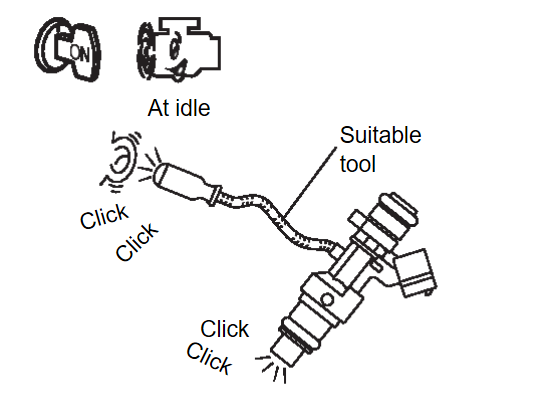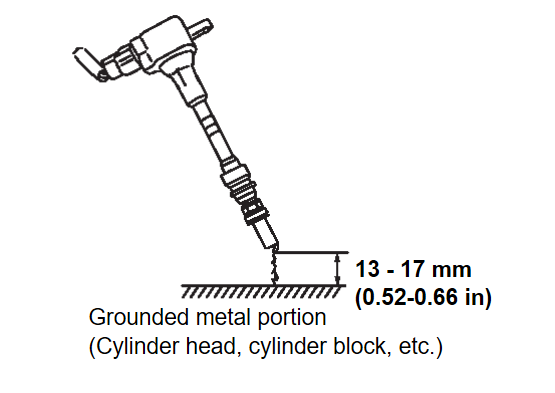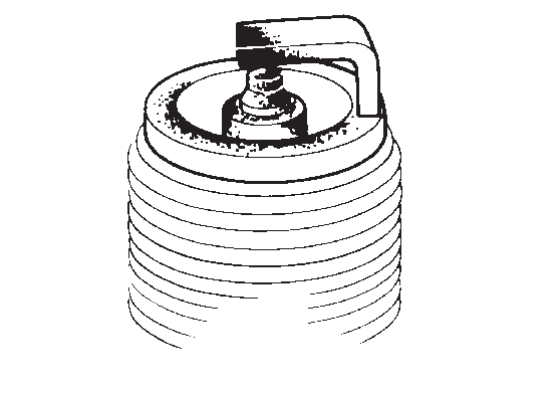DTC Diagnosis Procedure
| note | Do not replace A/F sensor when DTC P219A is detected. A/F sensor malfunction is not related to DTC P219A. |
1.CHECK DTC PRIORITY
If DTC P219A is displayed with other DTC, first perform the trouble diagnosis for the other DTC. Perform diagnosis of applicable. Refer to DTC Index
Perform diagnosis of applicable. Refer to DTC Index .
.
Is applicable DTC detected?
 Perform diagnosis of applicable. Refer to DTC Index
Perform diagnosis of applicable. Refer to DTC Index .
.2.CHECK FOR INTAKE AIR LEAK
- Stop engine and check the following for connection.
- Air duct
- Vacuum hoses
- PCV hose
- Intake air passage between air duct to intake manifold
- Start engine and let it idle.
- Listen for an intake air leak after the mass air flow sensor.
Is the inspection result normal?
 Repair or replace error-detected parts.
Repair or replace error-detected parts.3.CHECK EXHAUST GAS LEAK
- Stop engine and visually check exhaust tube, three way catalyst and muffler for dents connection.
- Start engine and let it idle.
- Listen for an exhaust gas leak before three way catalyst (manifold).
Is the inspection result normal?
 Repair or replace error-detected parts.
Repair or replace error-detected parts.4.CHECK FUEL PRESSURE
Is the inspection result normal?
5.CHECK MASS AIR FLOW SENSOR
 With M.U.T.-III SE
With M.U.T.-III SECheck “MASS AIR FLOW” in “DATA MONITOR” mode of “ENGINE” using M.U.T.-III SE.
For specification, Refer to MASS AIR FLOW SENSOR : Service Data .
.
 .
. With GST
With GSTCheck mass air flow sensor signal in Service $01 using GST.
For specification, Refer to MASS AIR FLOW SENSOR : Service Data .
.
 .
.Is the inspection result normal?
 Check connectors for rusted terminals or loose connections in the mass air flow sensor circuit or grounds. Refer to DTC Diagnosis Procedure
Check connectors for rusted terminals or loose connections in the mass air flow sensor circuit or grounds. Refer to DTC Diagnosis Procedure .
.6.CHECK FUNCTION OF FUEL INJECTOR-1
 With M.U.T.-III SE
With M.U.T.-III SE- Start engine.
- Perform "POWER BALANCE" in "Actuator TEST(in "Special Function")" mode of "ENGINE" using M.U.T.-III SE.
- Check that each circuit produces a momentary engine speed drop.
Is the inspection result normal?
 Perform trouble diagnosis for fuel injector, Refer to Component Function Check
Perform trouble diagnosis for fuel injector, Refer to Component Function Check .
.7.CHECK FUNCTION OF IGNITION COIL-1
| caution | Perform the following steps in a well-ventilated area with no combustibles. |
- Turn ignition switch OFF.
- Remove fuel pump fuse from IPDM E/R to release fuel pressure.
note M.U.T.-III SE must not be used to release fuel pressure. It develops again during the following steps, if released by using M.U.T.-III SE. - Start the engine.
- After an engine stall, crank the engine two or three times to release all the fuel pressure.
- Turn ignition switch OFF.
- Disconnect all the harness connectors of ignition coil to prevent electric discharge from occurring in ignition coil.
- Remove ignition coil assembly and spark plug of cylinder. Refer to Removal and Installation
 .
. - Crank engine for 5 seconds or more to remove combustion gas in the cylinder.
- Connect spark plug and harness connector to ignition coil.
- Allow a 13-17mm (0.52-0.66 in) spacing between spark plug and grounded metal portion as shown in the figure to fix the ignition coil with a rope or an equivalent.
- Crank the engine for approximately 3 seconds to see if sparking occurs between spark plug and the grounded metal portion.
Spark should be generated. caution - The discharge voltage becomes 20 kV or higher. Therefore, always stay away from the spark plug and ignition coil at least 50 cm (19.7 in) during the inspection.
- Leaving a space of more than 17mm (0.66 in) may damage the ignition coil.
note When the gap is less than 13 mm (0.52 in), a the spark might be generated even if the coil is malfunctioning.
Is the inspection result normal?
8.CHECK COMPRESSION PRESSURE
Check compression pressure. Refer to Inspection .
. Check intermittent incident. Refer to Intermittent IncidentIntermittent Incident
Check intermittent incident. Refer to Intermittent IncidentIntermittent Incident .
. Check pistons, piston rings, valves, valve seats and cylinder head gaskets.
Check pistons, piston rings, valves, valve seats and cylinder head gaskets.
 .
.Is the inspection result normal?
 Check intermittent incident. Refer to Intermittent IncidentIntermittent Incident
Check intermittent incident. Refer to Intermittent IncidentIntermittent Incident .
. Check pistons, piston rings, valves, valve seats and cylinder head gaskets.
Check pistons, piston rings, valves, valve seats and cylinder head gaskets.9.DETECT MALFUNCTIONING PART
Check fuel hoses and fuel tubes for clogging. Replace fuel filter and fuel pump assembly. Refer to Exploded View
Replace fuel filter and fuel pump assembly. Refer to Exploded View .
. Repair or replace error-detected parts.
Repair or replace error-detected parts.
Is the inspection result normal?
 Replace fuel filter and fuel pump assembly. Refer to Exploded View
Replace fuel filter and fuel pump assembly. Refer to Exploded View .
. Repair or replace error-detected parts.
Repair or replace error-detected parts.10.CHECK FUNCTION OF IGNITION COIL-2
- Turn ignition switch OFF.
- Disconnect spark plug and connect a non-malfunctioning spark plug.
- Crank engine for approximately 3 seconds, and recheck whether spark is generated between the spark plug and the grounded metal portion.
Spark should be generated.
Is the inspection result normal?
 Check ignition coil, power transistor and their circuits. Refer to Component Function Check
Check ignition coil, power transistor and their circuits. Refer to Component Function Check .
.11.CHECK SPARK PLUG
Check the initial spark plug for fouling, etc.
 Replace spark plug(s) with standard type one(s). For spark plug type, Refer to Spark Plug
Replace spark plug(s) with standard type one(s). For spark plug type, Refer to Spark Plug .
.
Is the inspection result normal?

- Repair or clean spark plug. Refer to Removal and Installation
 .
.  .
.
 Replace spark plug(s) with standard type one(s). For spark plug type, Refer to Spark Plug
Replace spark plug(s) with standard type one(s). For spark plug type, Refer to Spark Plug .
.12.CHECK FUNCTION OF IGNITION COIL-3
- Reconnect the initial spark plugs.
- Crank engine for approximately 3 seconds, and recheck whether spark is generated between the spark plug and the grounded portion.
Spark should be generated.
Is the inspection result normal?
 Check intermittent incident. Refer to Intermittent IncidentIntermittent Incident
Check intermittent incident. Refer to Intermittent IncidentIntermittent Incident .
. Replace spark plug(s) with standard type one(s). For spark plug type, Refer to Spark Plug
Replace spark plug(s) with standard type one(s). For spark plug type, Refer to Spark Plug .
.![[Previous]](../../../buttons/fprev.png)
![[Next]](../../../buttons/fnext.png)

 Without M.U.T.-III SE
Without M.U.T.-III SE

